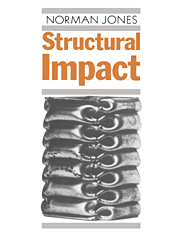Book contents
- Frontmatter
- Contents
- Preface
- 1 Static plastic behaviour of beams
- 2 Static plastic behaviour of plates and shells
- 3 Dynamic plastic behaviour of beams
- 4 Dynamic plastic behaviour of plates
- 5 Dynamic plastic behaviour of shells
- 6 Influence of transverse shear and rotatory inertia
- 7 Influence of finite displacements
- 8 Strain rate sensitive behaviour of materials
- 9 Dynamic progressive buckling
- 10 Dynamic plastic buckling
- 11 Scaling laws
- Appendices
- References
- Answers to selected problems
- Subject index
- Author index
5 - Dynamic plastic behaviour of shells
Published online by Cambridge University Press: 09 January 2010
- Frontmatter
- Contents
- Preface
- 1 Static plastic behaviour of beams
- 2 Static plastic behaviour of plates and shells
- 3 Dynamic plastic behaviour of beams
- 4 Dynamic plastic behaviour of plates
- 5 Dynamic plastic behaviour of shells
- 6 Influence of transverse shear and rotatory inertia
- 7 Influence of finite displacements
- 8 Strain rate sensitive behaviour of materials
- 9 Dynamic progressive buckling
- 10 Dynamic plastic buckling
- 11 Scaling laws
- Appendices
- References
- Answers to selected problems
- Subject index
- Author index
Summary
Introduction
The two previous chapters have examined the response of beams and plates when made from rigid, perfectly plastic materials and subjected to large dynamic loads. This chapter employs similar methods of analysis to study the dynamic stable response of shells.
Shells are thin-walled structural members having either one non-zero curvature (e.g., cylindrical and conical shells) or two non-zero curvatures (e.g., spherical and toroidal shells). They are used throughout engineering for storage (e.g., gas storage tanks), transportation (e.g., pipelines and railway tank cars) and for protection purposes (e.g., crash helmets), and are vital components of submersibles, offshore platforms, chemical plant and many other applications.
In some cases, the dynamic response occurs during normal operation as, for example, in an energy-absorbing cushion made of thin-walled shells which is positioned underneath an object dropped from an aircraft. However, it is also necessary to provide protection of some shell structures against unexpected loads, as might occur, for example, when a turbine disc bursts and produces energetic missiles which threaten shells containing hazardous substances.
It is evident that shell structures may have a variety of shapes and are subject to a wide range of internal and external dynamic loads. However, the structural response studied in this chapter is stable, while dynamic plastic buckling, or unstable behaviour, is examined in Chapter 10.
The shell structures of interest in this chapter are thin-walled and are subjected to dynamic loads which produce large plastic deformations. Thus, the general theoretical procedure for beams and plates, which is outlined in the two previous chapters, is again employed.
- Type
- Chapter
- Information
- Structural Impact , pp. 158 - 215Publisher: Cambridge University PressPrint publication year: 1990



